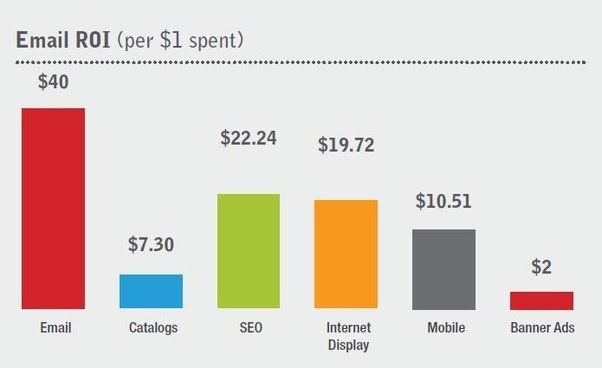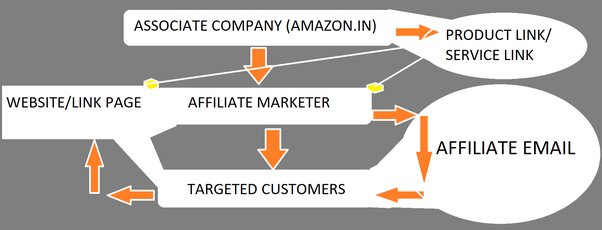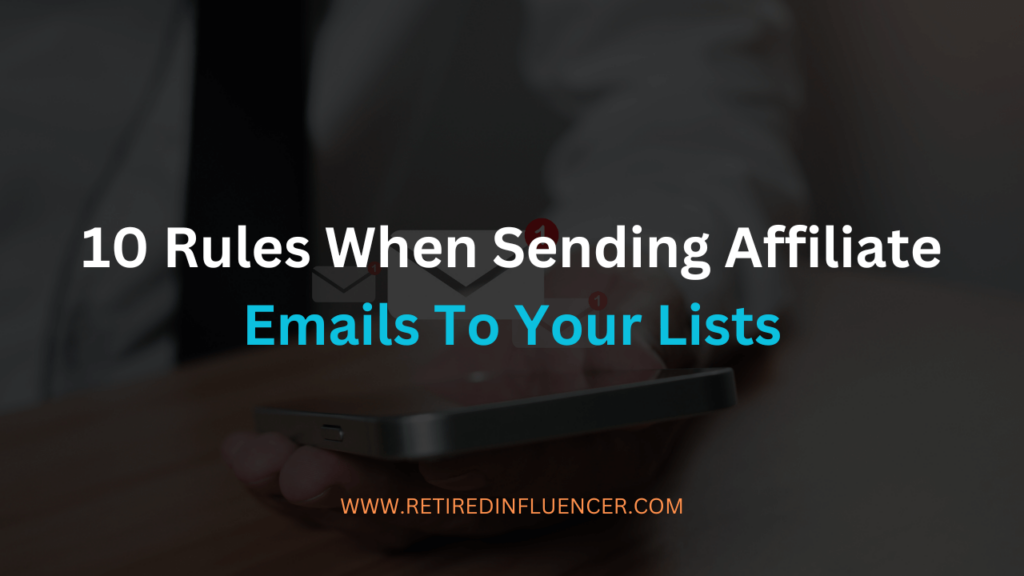There are so many rules to follow when sending affiliate emails to your list. One of these key rules is: Don’t send too many affiliate emails to your list in a short period of time.
Because people often get annoyed and unsubscribe if there are too many emails – particularly if that email is not adding any real value or information to their lives. Generally 1 – 2 emails per week maximum.
Table of Contents
What Are The Rules To Follow When Sending Affiliate Emails?
- Ensure Accuracy in Email Content
- Relevance of Email Subject Line
- Provide Contact Information
- Disclosure of Affiliate Links
- Avoid Misleading Headers
- Easy Unsubscribe Option
- Implement Opt-in Form
- Respect Copyrights
- Provide Valuable Content
- Monitor Email Performance
What Is Affiliate Email Marketing?
The concept idea behind affiliate email marketing is when you send a series of commercial or transactional email messages to your lists or subscribers delivering helpful or quality information and recommendations to earn affiliate commission or income.
In other words, affiliate email marketing is when you (affiliates) leverage your email lists to generate income by promoting relevant products or services to their subscribers.
P.S. I wrote another article where I went into more detail on how email marketing work for affiliate marketing. Check it out here.

Here’s a breakdown of how affiliate email marketing works:
- Affiliate Relationship: Affiliates partner with merchants or brands to promote their products or services to their email subscribers. Affiliates typically join affiliate programs provided by merchants or affiliate networks, where they receive unique tracking links to include in their promotional content.
- Email List Building: Affiliates build and maintain an email list of subscribers who have opted in to receive communications from them. These subscribers may have signed up through the affiliate’s website, blog, social media channels, or other marketing channels.
- Content Creation: Affiliates create engaging email content that promotes the merchant’s products or services to their subscribers. This content may include product reviews, recommendations, special offers, discounts, or informational content related to the products or services being promoted.
- Inclusion of Affiliate Links: Within the email content, affiliates include affiliate links that direct subscribers to the merchant’s website or product pages. These affiliate links contain unique tracking codes that identify the affiliate as the source of the referral.
- Promotion and Distribution: Affiliates send out their email campaigns to their subscriber list, promoting the merchant’s products or services. They may segment their email list based on subscriber interests, demographics, or past behavior to deliver targeted and relevant promotions.
- Commission Earning: When subscribers click on the affiliate links and make a purchase or complete a desired action (such as signing up for a service or filling out a form), the affiliate earns a commission. The commission structure may vary depending on the affiliate program and the specific terms negotiated between the affiliate and the merchant.
- Tracking and Analysis: Affiliates track the performance of their email campaigns using affiliate tracking software or tools provided by the affiliate program. They analyze key metrics such as click-through rates, conversion rates, and revenue generated to evaluate the effectiveness of their promotional efforts and optimize future campaigns.

10 Rules When Sending Affiliate Emails To Your Lists
1. Ensure Accuracy in Email Content
When crafting affiliate emails, it’s crucial to maintain accuracy right from the beginning.
This starts with the email heading, where your personal name, brand, or company name is prominently displayed.
Accuracy builds trust with your subscribers and sets the tone for transparent communication.
2. Relevance of Email Subject Line
The subject line of your email serves as the gateway to your content. It must be relevant and directly related to the actual content of your email.
Misleading subject lines can lead to frustration among subscribers and damage your credibility or reputation.
Therefore, you want to craft subject lines that accurately reflect the content inside is essential for maintaining engagement and trust.

3. Provide Contact Information
Transparency is key in email marketing. Including an actual address of yourself or your company at the bottom of your email adds a layer of legitimacy and trustworthiness.
It assures subscribers that there’s a real entity behind the emails they receive, fostering a sense of accountability and openness.
4. Disclosure of Affiliate Links
Affiliate marketing is a common practice in email campaigns, but transparency is paramount.
Clearly stating within your email content that it contains affiliate links that will earn you a commission is not only ethical but also a legal requirement in many jurisdictions.
This transparency builds trust with your audience and ensures compliance with regulations.
5. Avoid Misleading Headers
Misleading headers are a surefire way to erode trust and credibility with your subscribers.
Using deceptive tactics to entice people to open your emails can lead to high unsubscribe rates and tarnish your brand reputation or destroy the trust you spent years building with them.
It’s important to maintain honesty and integrity in all aspects of your email marketing efforts to foster long-term relationships with your audience.
6. Easy Unsubscribe Option
Respect your subscribers’ preferences by providing a clear and easy-to-find unsubscribe link in your emails.
This not only demonstrates compliance with anti-spam regulations but also respects the autonomy of your subscribers.
Making the unsubscribe process seamless ensures a positive user experience and helps maintain a healthy email list.
7. Implement Opt-in Form
Building an email list through opt-in forms is not only ethical but also highly effective.
By allowing visitors to willingly provide their email addresses, you ensure that your emails are reaching an engaged audience that has consented to receive your communications.
This approach not only minimizes the risk of being labeled as spam but also cultivates a loyal subscriber base.

8. Respect Copyrights
When creating content for your affiliate emails, always respect copyrights.
Using copyrighted materials such as photos and articles without proper authorization can lead to legal consequences, including lawsuits and damage to your reputation.
Instead, you want to focus on creating original content or obtaining permission to use third-party materials ethically.
9. Provide Valuable Content:
Offering valuable content in your emails keeps subscribers engaged and eager to hear from you.
Whether educational information, exclusive offers, or entertaining content, delivering value strengthens your relationship with your audience and encourages continued interaction.

10. Monitor Email Performance
Regularly monitor the performance of your email campaigns to see what’s working and what isn’t.
Analyze metrics such as Open rates, click-through rates, and conversions to understand what resonates with your audience and refine your strategies accordingly.
By tracking the performance of your email campaign, you can optimize future campaigns for better results.
FAQ’s
What are the rules of affiliate marketing?
Affiliate marketing is a broad niche in the digital marketing space and operates within a framework of rules and regulations to ensure fairness, transparency, and legality.
Some key rules include:
- Transparency: Disclose your affiliate relationships clearly and prominently to your audience.
- Compliance: Adhere to relevant laws and regulations governing affiliate marketing, such as the FTC guidelines in the United States.
- Accuracy: Ensure that your affiliate marketing content is truthful and accurately represents the products or services being promoted.
- Consent: Obtain consent from subscribers before sending affiliate emails, and provide an easy way for them to opt-out if they wish.
- Respect for intellectual property: Avoid copyright infringement by using original content or obtaining proper authorization for third-party materials.
How do you send affiliate emails?
Sending affiliate emails involves several key steps to ensure effectiveness and compliance.
1. First, compile a list of subscribers who have opted in to receive communications from you.
2. Craft compelling email content that provides value to your audience and includes relevant affiliate links.
3. Ensure transparency by clearly disclosing your affiliate relationships within the email.
4. Use an email marketing platform to design, schedule, and send affiliate emails to your subscriber list.
5. Monitor performance metrics to gauge your campaigns’ success and make necessary optimization adjustments or changes.
What are the best practices for crafting email subject lines in affiliate marketing?
Crafting effective subject lines is crucial in affiliate marketing. Begin by ensuring relevance to the content of your email, as this sets clear expectations for subscribers. Use compelling language to pique interest and encourage openness, while avoiding misleading tactics. A/B testing subject lines can help identify what resonates best with your list or audience, ultimately improving open rates and engagement.
How can I ensure compliance with regulations when including affiliate links in emails?
Compliance with regulations is essential when including affiliate links. Start by clearly disclosing your affiliate relationship in the email, ensuring transparency with subscribers. Additionally, familiarize yourself with relevant laws, such as the FTC guidelines in the United States, and adhere to them diligently. Regularly review and update your practices to stay compliant with evolving regulations.
Why is transparency important in disclosing affiliate relationships in email marketing?
Transparency builds trust with your audience in email marketing. Disclosing your affiliate relationships upfront demonstrates honesty and integrity, fostering a positive relationship with subscribers. It also helps maintain compliance with regulatory requirements, reducing the risk of legal repercussions. Ultimately, transparency cultivates a loyal subscriber base and enhances the credibility of your brand.
What are the consequences of using misleading headers in affiliate emails?
Using misleading headers in affiliate emails can have serious consequences. It can lead to a loss of trust and credibility with subscribers, resulting in high unsubscribe rates and damage to your brand reputation. Moreover, misleading tactics may violate anti-spam regulations and expose you to legal risks or penalties. Maintaining honesty and transparency in all aspects of your email marketing is paramount for long-term success.
How can I make it easy for subscribers to unsubscribe from my email list?
Making the unsubscribe process seamless is essential for subscriber satisfaction. Include a prominent unsubscribe link in every email, preferably near the footer, allowing subscribers to opt out with a single click. Ensure that the unsubscribe process is straightforward and immediate, respecting subscribers’ preferences and reducing the likelihood of spam complaints.
What are the benefits of implementing an opt-in form on my website for building an email list?
Implementing an opt-in form on your website offers several benefits for building an email list. It allows visitors to willingly provide their email addresses, ensuring that your emails reach an engaged audience that has consented to receive your newsletters or communications.
This approach minimizes the risk of being labeled as spam and fosters a sense of trust and transparency with subscribers.
Additionally, it enables you to target and segment your email list effectively, delivering more personalized content and driving higher engagement.
How do I avoid copyright infringement when creating content for affiliate emails?
Avoiding copyright infringement is essential in email marketing. Always create original content or obtain proper authorization to use third-party materials, such as photos and articles, in your emails. When in doubt, seek permission from the copyright owner or use licensed content from reputable sources.
Additionally, familiarize yourself with copyright laws and fair use guidelines to ensure compliance and mitigate the risk of legal issues.
What types of valuable content can I include in affiliate emails to keep subscribers engaged?
Including valuable content is key to keeping subscribers engaged in affiliate emails. Consider offering educational resources, exclusive offers, product reviews, or entertaining content that aligns with your audience’s interests and needs.
Personalize your emails based on subscriber preferences and behaviors to deliver relevant and compelling content.
Regularly monitor engagement metrics to identify what resonates best with your audience and refine your content strategy accordingly.
How do I track and analyze the performance of my affiliate email campaigns?
Tracking and analyzing the performance of your affiliate email campaigns is essential for optimizing results. Utilize email marketing analytics tools to monitor key metrics such as open rates, click-through rates, conversion rates, and subscriber engagement.
Segment your audience to gain insights into the effectiveness of different email campaigns and audience segments.
Use A/B testing to experiment with different elements of your emails and refine your strategies based on data-driven insights.
What are the key metrics to monitor when assessing the effectiveness of affiliate email marketing efforts?
Monitoring key metrics is crucial for assessing the effectiveness of affiliate email marketing efforts.
Key metrics to track include open rates, which indicate how many subscribers are opening your emails; click-through rates, which measure the percentage of recipients who click on links within your emails; conversion rates, which show how many recipients take a desired action after clicking on a link; and unsubscribe rates, which indicate subscriber dissatisfaction or disengagement.
Analyzing these metrics helps you identify areas for improvement and optimize your email marketing strategy for better results.
That’s It, Folks!
Email marketing is a powerful marketing tool in affiliate marketing but there are rules and regulations.
As an email marketer, following or adhering to the above-mentioned email marketing rules when sending affiliate emails to your lists or subscribers is essential for maintaining trust, compliance, and integrity in your email marketing efforts.
By prioritizing transparency, relevance, and respect for subscribers’ preferences and intellectual property rights, you can build stronger trust relationships with your audience and achieve long-term success in affiliate marketing activities.






